Spatiotemporal Evaluation of Water Resource Vulnerability in Four River Basins of Henan Province, China
Abstract
:1. Introduction
2. Materials and Methods
2.1. Study Area
2.2. Research Flowchart and Its Brief Introduction
2.3. Construction of Water Resource Vulnerability Index System
2.3.1. VSD Integration Framework and SERV Vulnerability Model
2.3.2. Selection of Water Resource Vulnerability Indicators
- (1)
- Exposure: This dimension captures the extent to which a system is exposed to external perturbations or stresses [17,63,65]. Elevated exposure intensifies the propensity for water-centric adversities. Within the designated study region, primary sources of exposure are rooted in human endeavors, epitomized by factors such as population dispersion, industrial alignments, and land utilization patterns.
- (2)
- Sensitivity: This gauges the potential impact, be it detrimental or beneficial, on a unit due to stressors [54,66]. The magnitude of such effects is contingent upon the nature of exposure and intrinsic system attributes. In the examined region, sensitivity predominantly emerges from aspects like water insufficiency, contamination, and recurrent water-centric calamities. These are intrinsically linked with natural resource circumstances and climatic shifts.
- (3)
- Adaptability: This dimension underscores the resilience and recuperative capacity of a water resource system when confronted with stressors and their subsequent repercussions [15,21,64]. Enhancement in adaptability can be channeled through deliberate human interventions or adaptive stewardship. Components such as recuperation duration, the scope of recovery, and rate of restoration typify adaptability. Within the study’s purview, factors like socio-economic progression and investments towards ecological endeavors offer insights into adaptability [8].
2.4. Data Source and Standardization
2.4.1. Data Source
2.4.2. Data Standardization
2.5. Determination of Weights Using Combined Weighting Method
2.6. Spatial Feature Analysis Using Standard Deviational Ellipse
2.7. Factor Analysis Using GeoDetector
3. Results
3.1. Spatiotemporal Characteristics of WRV in the Four Basins
3.1.1. Spatiotemporal Changes in the Exposure, Sensitivity, Adaptive Capacity, and Vulnerability Index of WRV in the Four Basins
3.1.2. Spatial Variations in the Centroids of WRV’s Exposure, Sensitivity, Adaptive Capacity, and Vulnerability Index in the Four Basins
3.2. Factors Influencing WRV in the Four River Basins
4. Discussion
4.1. Spatiotemporal Pattern of WRV’s Exposure, Sensitivity, Adaptability, and Vulnerability Indices in the Four Basins
4.1.1. Spatiotemporal Pattern of the Exposure Index in the WRV
4.1.2. Spatiotemporal Pattern of the Sensitivity Index in the WRV
4.1.3. Spatiotemporal Pattern of the Adaptation Capacity Index in the WRV
4.1.4. Spatiotemporal Pattern of the Vulnerability Index in the WRV
4.2. Application of WRV Evaluation: Identifying the Focus of Water Resource Adaptive Management
5. Conclusions
- (1)
- An analysis of spatiotemporal trends highlighted a consistent reduction in WRV from 2000 to 2020. Significantly, vulnerability was positively correlated with exposure, while a negative correlation was observed with adaptability. The temporal trend of exposure initially indicated an increase, followed by a subsequent decrease, exhibiting a spatial pattern described as “higher in the northeast and lower in the southwest”. Sensitivity initially decreased and then stabilized over time, with a spatial distribution characterized by “higher in the north and lower in the south”. Adaptability demonstrated a consistently increasing temporal trend, along with a spatial pattern of “lower in the northeast and higher in the southwest”. Consequently, the overall vulnerability showed a decreasing trend over time and was spatially “higher in the northeast and lower in the southwest”.
- (2)
- There were marked differences among the four basins regarding WRV. In each basin, WRV was shaped by the interaction and mutual influence of three dimensions: exposure, sensitivity, and adaptability. The Yellow River and Hai River basins displayed heightened WRV, primarily due to the intricate interplay between exposure and sensitivity factors. In contrast, the Huai River and Yangtze River basins, characterized by relatively lower population density and more abundant water resources, exhibited lower WRV. Consequently, it is essential to manage each watershed adaptively, taking into account its distinct characteristics. This includes implementing management measures such as balancing water resource supply and demand, enhancing protection of the water environment, and refining watershed governance mechanisms.
Author Contributions
Funding
Data Availability Statement
Acknowledgments
Conflicts of Interest
References
- Yuan, Y.; Zheng, Y. Progress and future prospects of water resources vulnerability at home and abroad. J. Arid Land Resour. Environ. 2022, 36, 116–125. [Google Scholar]
- Bakker, K.; Morinville, C. The governance dimensions of water security: A review. Philos. Trans. R. Soc. A-Math. Phys. Eng. Sci. 2013, 371, 20130116. [Google Scholar] [CrossRef] [PubMed]
- Adger, W.N. Vulnerability. Glob. Environ. Chang. 2006, 16, 268–281. [Google Scholar] [CrossRef]
- Birch, E.L. Climate Change 2014: Impacts, Adaptation, and Vulnerability. J. Am. Plan. Assoc. 2014, 80, 184–185. [Google Scholar] [CrossRef]
- Chen, Y.; Moufouma-Okia, W.; Masson-Delmotte, V.; Zhai, P.; Pirani, A. Recent Progress and Emerging Topics on Weather and Climate Extremes Since the Fifth Assessment Report of the Intergovernmental Panel on Climate Change. Annu. Rev. Environ. Resour. 2018, 43, 35–59. [Google Scholar] [CrossRef]
- Gu, S.; Jenkins, A.; Gao, S.-J.; Lu, Y.; Li, H.; Li, Y.; Ferrier, R.C.; Bailey, M.; Wang, Y.; Zhang, Y.; et al. Ensuring water resource security in China; the need for advances in evidence-based policy to support sustainable management. Environ. Sci. Policy 2017, 75, 65–69. [Google Scholar] [CrossRef]
- Chen, W.; Chen, Y.; Feng, Y. Assessment and Prediction of Water Resources Vulnerability Based on a NRS-RF Model: A Case Study of the Song-Liao River Basin, China. Entropy 2021, 23, 882. [Google Scholar] [CrossRef]
- Xiao, A.; Long, J.; Wu, J.; Wang, W. Using VSD Model to Analyze Water Resource Vulnerability in Wet Mountain Region: Taking Xiangxi Tujiazu & Miaozu Autonomous Prefecture as an Example. J. Irrig. Drain. 2022, 41, 45–53. [Google Scholar]
- Yang, F.; Zheng, L.; Qian, H.; Liu, F.; Wang, H. Vulnerability assessment of urban water resources based on DPSIR model: A case study of Xi’an City. J. Water Resour. Water Eng. 2020, 31, 77–84. [Google Scholar]
- Kim, H.J.; Cho, K.; Kim, Y.; Park, H.; Lee, J.W.; Kim, S.J.; Chae, Y. Spatial Assessment of Water-Use Vulnerability under Future Climate and Socioeconomic Scenarios within a River Basin. J. Water Resour. Plan. Manag. 2020, 146, 05020011. [Google Scholar] [CrossRef]
- Pietrucha-Urbanik, K.; Rak, J. Water, Resources, and Resilience: Insights from Diverse Environmental Studies. Water 2023, 15, 3965. [Google Scholar] [CrossRef]
- Rak, J.R.; Pietrucha-Urbanik, K. An Approach to Determine Risk Indices for Drinking Water-Study Investigation. Sustainability 2019, 11, 3189. [Google Scholar] [CrossRef]
- Dong, Y.; Zhou, W.; Wang, X.; Lu, Y.; Zhao, P.; Li, X. A new assessment method for the vulnerability of confined water: W-F&PNN method. J. Hydrol. 2020, 590, 125217. [Google Scholar] [CrossRef]
- Gao, S.; Luo, Y.; Yang, T. Research on Analysis and Evaluation Method of Vulnerability of Water Resources System. IOP Conf. Ser. Earth Environ. Sci. 2019, 233, 042026. [Google Scholar] [CrossRef]
- Wei, S.; Lin, K.; Huang, L.; Yao, Z.; Bai, X.; Chen, Z. Assessing the Vulnerability of Water Resources System Using VSD-SD Coupling Model: A Case of Pearl River Delta. Water 2022, 14, 1103. [Google Scholar] [CrossRef]
- Xia, J.; Shi, W.; Chen, J.; Hong, S. Study on vulnerability of water resources and its adaptive regulation under changing environment A case of Haihe River Basin. Water Resour. Hydropower Eng. 2015, 46, 27–33. [Google Scholar]
- Chen, J.; Yang, X.; Yin, S.; Wu, K. The vulnerability evolution and simulation of the social-ecological systems in the semi-arid area based on the VSD framework. Acta Geogr. Sin. 2016, 71, 1172–1188. [Google Scholar]
- Demirkesen, A.C.; Evrendilek, F. Compositing climate change vulnerability of a Mediterranean region using spatiotemporally dynamic proxies for ecological and socioeconomic impacts and stabilities. Environ. Monit. Assess. 2017, 189, 29. [Google Scholar] [CrossRef]
- Lin, Z.; Liu, B.; Wu, Y.; Peng, S. Assessment of water resource vulnerability of the Pearl River Delta metropolitan under environment change. Acta Sci. Nat. Univ. Sunyatseni 2018, 57, 8–16. [Google Scholar]
- Wang, X.; Ma, F.B.; Li, J.Y. Water Resources Vulnerability Assessment based on the Parametric-system Method: A Case Study of the Zhangjiakou Region of Guanting Reservoir Basin, North China. Procedia Environ. Sci. 2012, 13, 1204–1212. [Google Scholar] [CrossRef]
- Huo, T.; Zhang, X.; Zhou, Y.; Chen, W. Evaluation and correlation analysis of spatio-temporal changes of ecological vulnerability based on VSD model: A case in Suzhou section, Grand Canal of China. Acta Ecol. Sin. 2022, 42, 2281–2293. [Google Scholar]
- Chen, Y.; Feng, Y.; Zhang, F.; Wang, L. Assessing Water Resources Vulnerability by Using a Rough Set Cloud Model: A Case Study of the Huai River Basin, China. Entropy 2019, 21, 14. [Google Scholar] [CrossRef] [PubMed]
- Haak, L.; Pagilla, K. The Water-Economy Nexus: A Composite Index Approach to Evaluate Urban Water Vulnerability. Water Resour. Manag. 2020, 34, 409–423. [Google Scholar] [CrossRef]
- Polsky, C.; Neff, R.; Yarnal, B. Building comparable global change vulnerability assessments: The vulnerability scoping diagram. Glob. Environ. Chang.-Hum. Policy Dimens. 2007, 17, 472–485. [Google Scholar] [CrossRef]
- Frazier, T.G.; Thompson, C.M.; Dezzani, R.J. A framework for the development of the SERV model: A Spatially Explicit Resilience-Vulnerability model. Appl. Geogr. 2014, 51, 158–172. [Google Scholar] [CrossRef]
- Chen, J.; Yang, X.; Yin, S.; Wu, K.; Deng, M.; Wen, X. The vulnerability evolution and simulation of social-ecological systems in a semi-arid area: A case study of Yulin City, China. J. Geogr. Sci. 2018, 28, 152–174. [Google Scholar] [CrossRef]
- Chen, Y.; Feng, Y. Assessment and Prediction of Water Resources Vulnerability in River Basin Based on RS-SVR Model: A Case Study of the Yellow River Basin. Resour. Environ. Yangtze Basin 2020, 29, 137–149. [Google Scholar]
- Liu, Q.; Chen, Y. Vulnerability prediction of basin water resources based on rough set and bp neural networka case of huaihe basin. Resour. Environ. Yangtze Basin 2016, 25, 1317–1327. [Google Scholar]
- Pandey, V.P.; Babel, M.S.; Shrestha, S.; Kazama, F. Vulnerability of freshwater resources in large and medium Nepalese river basins to environmental change. Water Sci. Technol. 2010, 61, 1525–1534. [Google Scholar] [CrossRef]
- Chen, Y.; Feng, Y.; Zhang, F.; Yang, F.; Wang, L. Assessing and Predicting the Water Resources Vulnerability under Various Climate-Change Scenarios: A Case Study of Huang-Huai-Hai River Basin, China. Entropy 2020, 22, 333. [Google Scholar] [CrossRef]
- Qin, J.; Ding, Y.-J.; Zhao, Q.-D.; Wang, S.-P.; Chang, Y.-P. Assessments on surface water resources and their vulnerability and adaptability in China. Adv. Clim. Chang. Res. 2020, 11, 381–391. [Google Scholar] [CrossRef]
- Feng, Y.; He, D. Transboundary water vulnerability and its drivers in China. J. Geogr. Sci. 2009, 19, 189–199. [Google Scholar] [CrossRef]
- Kuang, Y.; Li, H.; Xia, J.; Yang, Z. Impacts of climate change on transboundary water resources and adaptation management framework. Progress. Inquisitiones De Mutat. Clim. 2018, 14, 67–76. [Google Scholar]
- Zhong, S.; Elzarka, H. Retrospective Evaluation of the Vulnerability of Watershed Sustainable Water Development Using a Time-Series-Based Space Geometry Model: Xiang Jiang Watershed, China. J. Hydrol. Eng. 2021, 26, 05021023. [Google Scholar] [CrossRef]
- Zhao, Y.; Xu, X.; Li, X. Evaluation of Water environmental System Vulnerability in Jiangsu Province Based on Weight-Varying Gray Cloud Model. Resour. Environ. Yangtze Basin 2018, 27, 2463–2471. [Google Scholar]
- Li, M.-H.; Tseng, K.-J.; Tung, C.-P.; Shih, D.-S.; Liu, T.-M. Assessing water resources vulnerability and resilience of southern Taiwan to climate change. Terr. Atmos. Ocean. Sci. 2017, 28, 67–81. [Google Scholar] [CrossRef]
- Garnier, M.; Holman, I. Critical Review of Adaptation Measures to Reduce the Vulnerability of European Drinking Water Resources to the Pressures of Climate Change. Environ. Manag. 2019, 64, 138–153. [Google Scholar] [CrossRef]
- Xia, J.; Shi, W.; Luo, X.; Hong, S.; Ning, L.; Gippel Christopher, J. Revisions on water resources vulnerability and adaption measures under climate change. Adv. Water Sci. 2015, 26, 279–286. [Google Scholar]
- Zuo, Q.T.; Li, W.; Zhao, H.; Ma, J.X.; Han, C.H.; Luo, Z.L. A Harmony-Based Approach for Assessing and Regulating Human-Water Relationships: A Case Study of Henan Province in China. Water 2021, 13, 32. [Google Scholar] [CrossRef]
- Zhang, L.; Qiu, S.; Yan, L.; Du, J.; Shen, H.; Zhang, R. Coupling and Coordination Analysis of Water Resources Utilization and Economic and Social Development in Henan Province from the Perspective of Basin. Areal Res. Dev. 2022, 41, 14–19. [Google Scholar]
- Xu, W.; Wang, Z.; Zhang, T. Spatial Heterogeneity Analysis of Water Environment in the Huaihe River Basin of Henan Province. Wetl. Sci. 2017, 15, 425–432. [Google Scholar]
- Xu, Y.; Yu, L.; Lyu, X.; Fan, P. Ecological restoration modes for Huaihe River basin of Henan, China. Chin. J. Environ. Eng. 2017, 11, 143–150. [Google Scholar]
- Jiao, S.; Cui, S.; Wang, A.; Zhao, R.; Yin, Y.; Zhang, J.; Li, Z. Response Relationship Between Urbanization Process and Water Resource Utilization in Henan Province. Res. Soil Water Conserv. 2020, 27, 239–246. [Google Scholar]
- Yan, L.; Zhao, Y.; Qiu, S.; Fu, Q. Construction and Evaluation of High-quality Development Index System in the Yellow River Basin: Take Henan Section as an Example. Areal Res. Dev. 2022, 41, 37–43. [Google Scholar]
- Yang, Q.; Tang, Q.; Zhang, Y. Spatiotemporal Changes of Water Quality in Huai River Basin(Henan Section) and Its Correlation with Land Use Patterns. Res. Environ. Sci. 2019, 32, 1519–1530. [Google Scholar]
- Li, X.; Yu, L.; Lu, X.; Xu, Y.; Hao, Z. Health assessment of aquatic ecosystem in Huai River Basin (Henan section) based on B-IBI. Chin. J. Ecol. 2018, 37, 2213–2220. [Google Scholar]
- Daly, D.; Dassargues, A.; Drew, D.; Dunne, S.; Goldscheider, N.; Neale, S.; Popescu, I.; Zwahlen, F. Main concepts of the “European approach” to karst-groundwater-vulnerability assessment and mapping. Hydrogeol. J. 2002, 10, 340–345. [Google Scholar] [CrossRef]
- Acosta-Michlik, L.; Espaldon, V. Assessing vulnerability of selected farming communities in the Philippines based on a behavioural model of agent’s adaptation to global environmental change. Glob. Environ. Chang.-Hum. Policy Dimens. 2008, 18, 554–563. [Google Scholar] [CrossRef]
- Huo, Y.; Wang, L.; Jiao, S.; Teng, J. Water pollution driving forces and pollution prevention measures priority of medium/small-sized cities in southern China. China Environ. Sci. 2009, 29, 1052–1058. [Google Scholar]
- Wang, W.; Jin, J.; Ding, J.; Li, Y. A new approach to water resources system assessment—Set pair analysis method. Sci. China Ser. E Technol. Sci. 2009, 52, 3017–3023. [Google Scholar] [CrossRef]
- Xiang, H. Research on Construction and Application of Index System for Regional Water Security Assessment; Jinan Universtiy: Guangzhou, China, 2011. [Google Scholar]
- Tu, J.; Luo, S.; Yang, Y.; Qin, P.; Qi, P.; Li, Q. Spatiotemporal Evolution and the Influencing Factors of Tourism-Based Social-Ecological System Vulnerability in the Three Gorges Reservoir Area, China. Sustainability 2021, 13, 4008. [Google Scholar] [CrossRef]
- Frazier, T.; Thompson, C.; Dezzani, R. Development of a spatially explicit vulnerability-resilience model for community level hazard mitigation enhancement. In Disaster Management and Human Health Risk III; Brebbia, C.A., Ed.; WIT Press: Southampton, UK, 2013; pp. 13–24. [Google Scholar]
- Gong, J.; Jin, T.; Cao, E.; Wang, S.; Yan, L. Is ecological vulnerability assessment based on the VSD model and AHP-Entropy method useful for loessial forest landscape protection and adaptative management? A case study of Ziwuling Mountain Region, China. Ecol. Indic. 2022, 143, 109379. [Google Scholar] [CrossRef]
- Khashei-Siuki, A.; Sharifan, H. Comparison of AHP and FAHP methods in determining suitable areas for drinking water harvesting in Birjand aquifer. Iran. Groundw. Sustain. Dev. 2020, 10, 100328. [Google Scholar] [CrossRef]
- Zou, T.; Chang, Y.; Chen, P.; Liu, J. Spatial-temporal variations of ecological vulnerability in Jilin Province (China), 2000 to 2018. Ecol. Indic. 2021, 133, 108429. [Google Scholar] [CrossRef]
- Guo, K.; Yuan, Y.B. Research on Spatial and Temporal Evolution Trends and Driving Factors of Green Residences in China Based on Weighted Standard Deviational Ellipse and Panel Tobit Model. Appl. Sci. 2022, 12, 8788. [Google Scholar] [CrossRef]
- Wuyan, F.; Yong, Z. Based on ARCGIS-SDE Spatial Evolution Trend of Industrial Clusters Space. Appl. Mech. Mater. 2015, 733, 982–985. [Google Scholar] [CrossRef]
- Moore, T.W.; McGuire, M.P. Using the standard deviational ellipse to document changes to the spatial dispersion of seasonal tornado activity in the United States. NPJ Clim. Atmos. Sci. 2019, 2, 21. [Google Scholar] [CrossRef]
- An, M.; Xie, P.; He, W.; Wang, B.; Huang, J.; Khanal, R. Spatiotemporal change of ecologic environment quality and human interaction factors in three gorges ecologic economic corridor, based on RSEI. Ecol. Indic. 2022, 141, 109090. [Google Scholar] [CrossRef]
- Wang, J.; Xu, C. Geodetector: Principle and prospective. Acta Geogr. Sin. 2017, 72, 116–134. [Google Scholar]
- Liu, Y.; Zhang, W.; Zhang, Z.; Xu, Q.; Li, W. Risk factor detection and landslide susceptibility mapping using Geo-Detector and Random Forest Models: The 2018 Hokkaido eastern Iburi earthquake. Remote Sens. 2021, 13, 1157. [Google Scholar] [CrossRef]
- Li, X.; Huang, Z.; Chen, J.; Wang, X.; Wei, J. Preliminary assessment of Tieshangang Bay mangrove ecosystem vulnerability based on VSD model. J. Trop. Oceanogr. 2018, 37, 47–54. [Google Scholar]
- Chen, F.; Li, Z.; Dong, S.; Ren, Y.; Li, J.; Rykov Pavel, V. Evaluation of ecological vulnerability in gully-hilly region of Loess Plateau based on VSD ModelA case of Lintao county. J. Arid Land Resour. Environ. 2018, 32, 74–80. [Google Scholar]
- Dang, E.; Hu, W.; Chen, G.; Ma, Z.; Cehn, B.; Chen, Z.; Liu, W. Ecological vulnerability assessment of coastal zone in Dongshan county based on VSD model. Mar. Environ. Sci. 2017, 36, 296–302. [Google Scholar]
- Li, J.; Zhang, J.; Si, Y.; Liu, Y.; Liu, Q.; Lu, W. System analysis of Xiangshan bay ecological vulnerability assessment system based on VSD model. Mar. Environ. Sci. 2017, 36, 274–280. [Google Scholar]
- Fu, Y.; Liu, Y. The RST Evaluation Method of Indicator System Validity and Its Application. Manag. Rev. 2009, 21, 91–95,112. [Google Scholar]
- Hu, X.; Zhang, L. Research on the integration level measurement and optimization path of industrial chain, innovation chain and service chain. J. Innov. Knowl. 2023, 8, 100368. [Google Scholar] [CrossRef]
- Henan Province Water Authority. Henan Province Water Resources Bulletin, Henan Province, China. Available online: https://slt.henan.gov.cn/bmzl/szygl/szygb/ (accessed on 23 October 2022).
- Henan Province Bureau of Statistics. Henan Provincial Statistical Yearbook, Henan Province, China. Available online: https://tjj.henan.gov.cn/tjfw/tjsj/ (accessed on 23 October 2022).
- Murthy, C.S.; Laxman, B.; Sai, M.V.R.S. Geospatial analysis of agricultural drought vulnerability using a composite index based on exposure, sensitivity and adaptive capacity. Int. J. Disaster Risk Reduct. 2015, 12, 163–171. [Google Scholar] [CrossRef]
- Xu, H. Assessment of agricultural drought vulnerability and identification of influencing factors based on the entropy weight method. Agric. Res. Arid Areas 2016, 34, 198–205. [Google Scholar]
- Tan, L.; Wu, X.; Guo, J.; Santibanez-Gonzalez, E.D.R. Assessing the Impacts of COVID-19 on the Industrial Sectors and Economy of China. Risk Anal. 2022, 42, 21–39. [Google Scholar] [CrossRef]
- Okolie, C.C.; Ogundeji, A.A. Effect of COVID-19 on agricultural production and food security: A scientometric analysis. Humanit. Soc. Sci. Commun. 2022, 9, 64. [Google Scholar] [CrossRef]
- Cui, K.; Liu, D.; Li, X. Evaluation on Social Vulnerability to Flood Hazards in He’nan Section of Yellow River Basin. Bull. Soil Water Conserv. 2021, 41, 304–310. [Google Scholar]
- Xiang-yi, D.; Yang-Wen, J.I.A.; Hao, W.; Cun-Wen, N.I.U. Impacts of Climate Change on Water Resources in the Haihe River Basin and Corresponding Countermeasures. J. Nat. Resour. 2010, 25, 604–613. [Google Scholar]
- Cheng, S.; Xie, J.; Ma, N.; Liang, S.; Guo, J.; Fu, N. Variations in Summer Precipitation According to Different Grades and Their Effects on Summer Drought/Flooding in Haihe River Basin. Atmosphere 2022, 13, 1246. [Google Scholar] [CrossRef]
- Jiang, Y.; Hao, Z.; Feng, S.; Zhang, Y.; Zhang, X.; Fu, Y.; Hao, F. Spatiotemporal evolution characteristics in compound hot-dry events in Yangtze River and Yellow River basins. Water Resour. Prot. 2023, 39, 70–77. [Google Scholar]
- Fang, L.; Xu, D.; Wang, L.; Niu, Z.; Zhang, M. The study of ecosystem services and the comparison of trade-off and synergy in Yangtze River Basin and Yellow River Basin. Geogr. Res. 2021, 40, 821–838. [Google Scholar]
- Gong, S.; Xiao, Y.; Zheng, H.; Xiao, Y.; Ouyang, Z. Spatial patterns of ecosystem water conservation in China and its impact factors analysis. Acta Ecol. Sin. 2017, 37, 2455–2462. [Google Scholar]
- Li, R.; Huang, X.; Liu, Y. Spatio-temporal differentiation and influencing factors of China’s urbanization from 2010 to 2020. Acta Geogr. Sin. 2023, 78, 777–791. [Google Scholar]
- Xu, J.; Yuan, Z. Drought Characteristics of Changjiang River Basin in 2022 and Drought Mitigation Response Pattern under New Circumstances. J. Yangtze River Sci. Res. Inst. 2023, 40, 1–8. [Google Scholar]
- Wei, J.; Li, Z.; Dong, Y. Legalization of Environmental Safety Assessment System in the Yellow River Basin Based on Pressure-State-Response (PSR) Model. Environ. Monit. China 2023, 39, 19–28. [Google Scholar]
- Pan, B.; Liu, X. A Review of Water Ecology Problems and Restoration in the Yangtze River Basin. J. Yangtze River Sci. Res. Inst. 2021, 38, 1–8. [Google Scholar]
- Zhang, J.; Wang, G.; Jin, J.; He, R.; Liu, C. Evolution and variation characteristics of the recorded runoff for the major rivers in China during 19562018. Adv. Water Sci. 2020, 31, 153–161. [Google Scholar]
- Cai, J.; Varis, L.; Yin, H. China’s water resources vulnerability: A spatio-temporal analysis during 2003–2013. J. Clean. Prod. 2017, 142, 2901–2910. [Google Scholar] [CrossRef]
- Li-ping, Z.; Jun, X.I.A. Situation and problem analysis of water resource security in China. Resour. Environ. Yangtze Basin 2009, 18, 116–120. [Google Scholar]
- Guan, X.; Wei, H.; Lu, S.; Dai, Q.; Su, H. Assessment on the urbanization strategy in China: Achievements, challenges and reflections. Habitat Int. 2018, 71, 97–109. [Google Scholar] [CrossRef]
- Yang, Q.; Gao, D.; Song, D.; Li, Y. Environmental regulation, pollution reduction and green innovation: The case of the Chinese Water Ecological Civilization City Pilot policy. Econ. Syst. 2021, 45, 100911. [Google Scholar] [CrossRef]
- Yang, C.; Yu, Z.; Hao, Z.; Zhang, J.; Zhu, J. Impact of climate change on flood and drought events in Huaihe River Basin, China. Hydrol. Res. 2012, 43, 14–22. [Google Scholar] [CrossRef]
- Ren, J.; Wang, W.; Wei, J.; Li, H.; Li, X.; Liu, G.; Chen, Y.; Ye, S. Evolution and prediction of drought-flood abrupt alternation events in Huang-Huai-Hai River Basin, China. Sci. Total Environ. 2023, 869, 161707. [Google Scholar] [CrossRef]
- Shi, X.; Ding, H.; Wu, M.; Zhang, N.; Shi, M.; Chen, F.; Li, Y. Effects of different types of drought on vegetation in Huang-Huai-Hai River Basin, China. Ecol. Indic. 2022, 144, 109428. [Google Scholar] [CrossRef]
- Sun, R.; Yuan, H.; Liu, X.; Jiang, X. Evaluation of the latest satellite–gauge precipitation products and their hydrologic applications over the Huaihe River basin. J. Hydrol. 2016, 536, 302–319. [Google Scholar] [CrossRef]
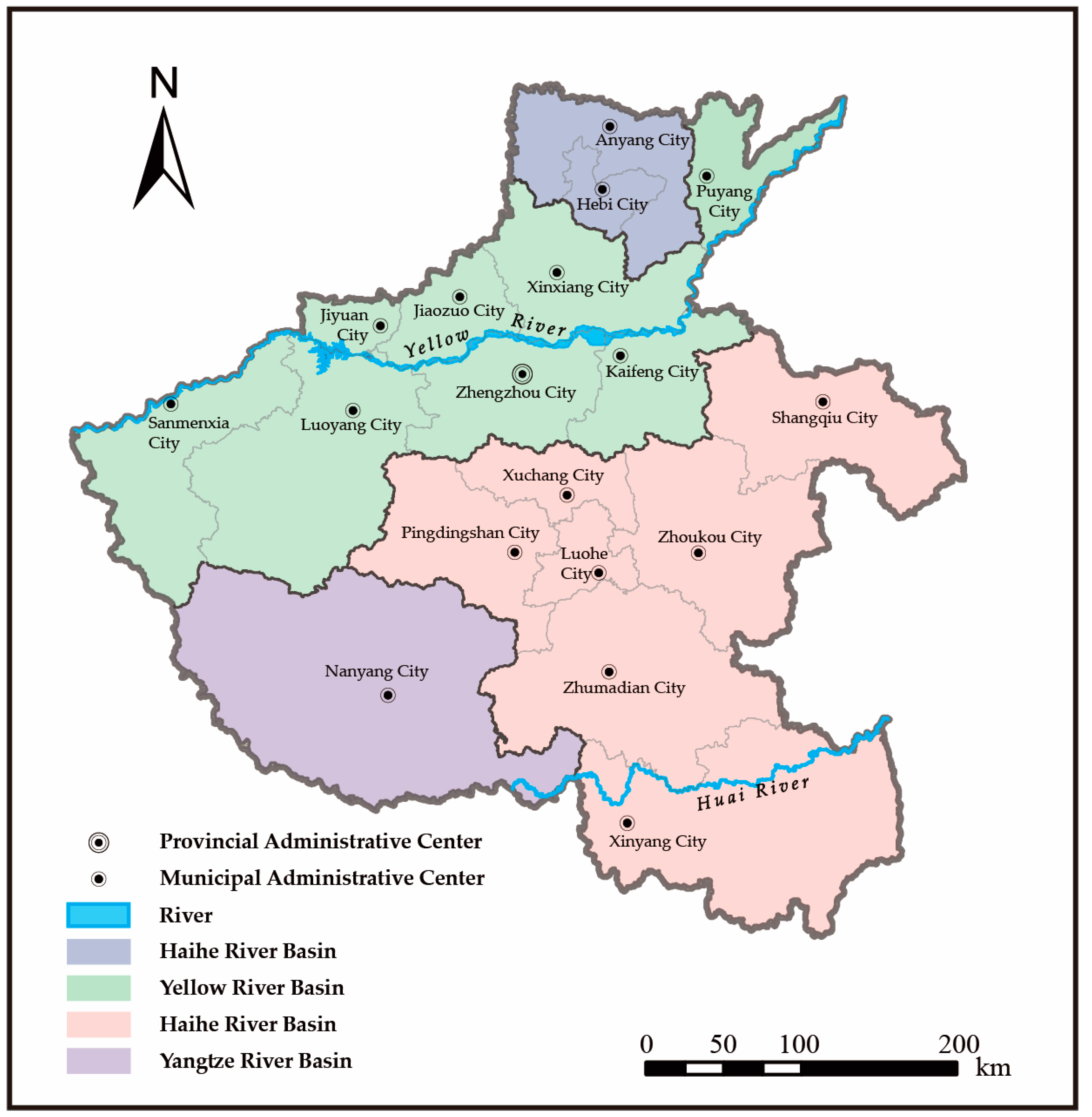



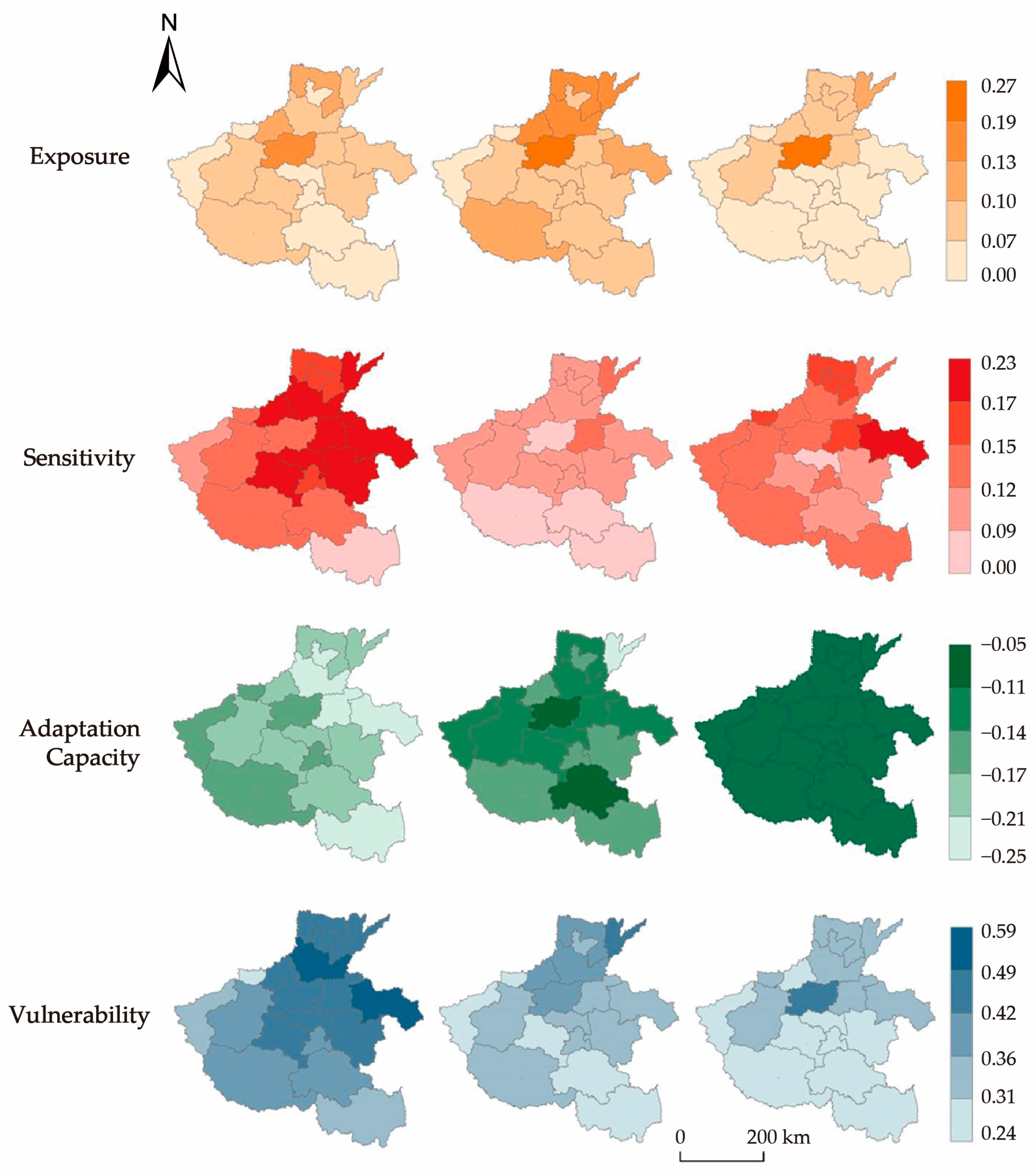


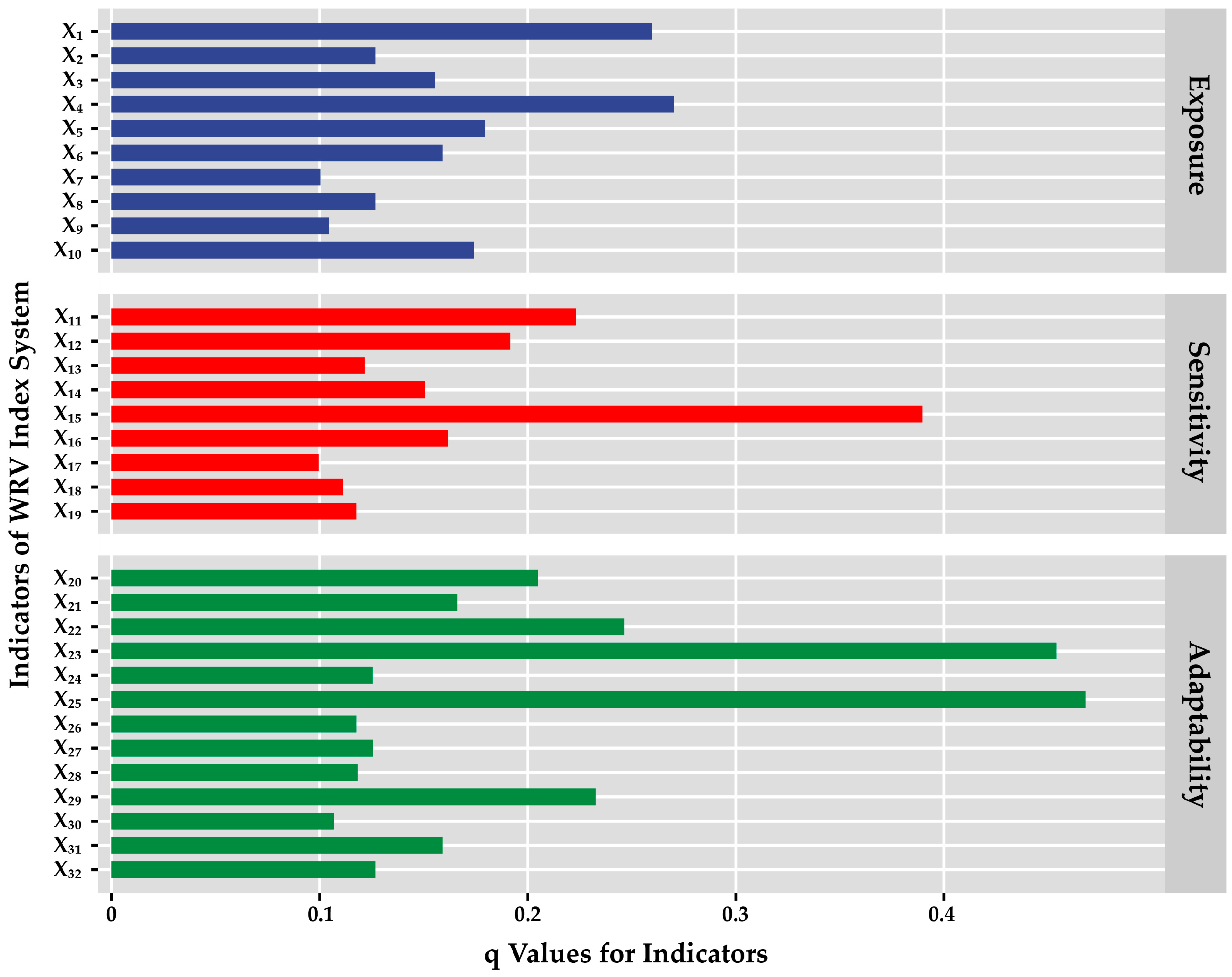
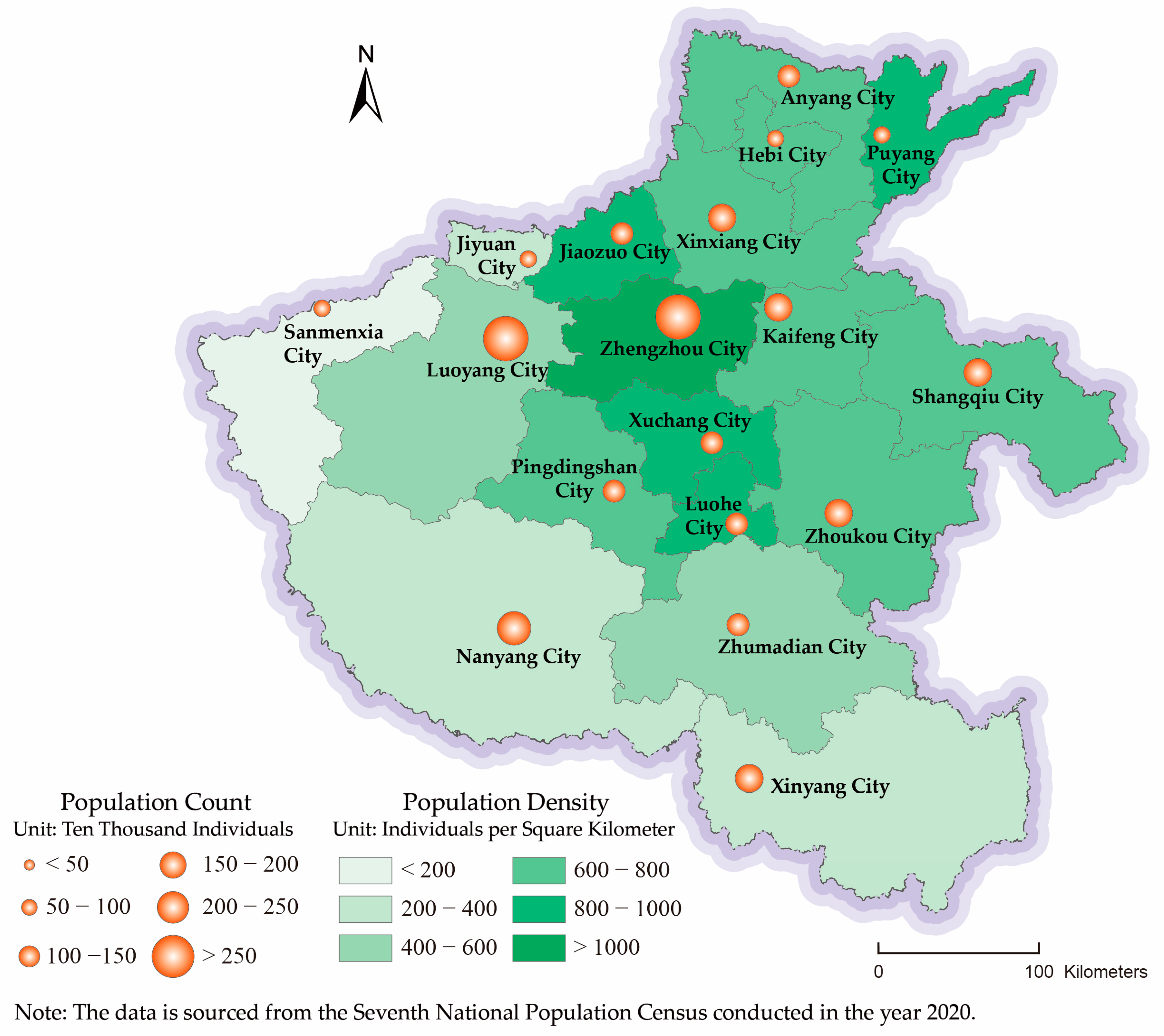
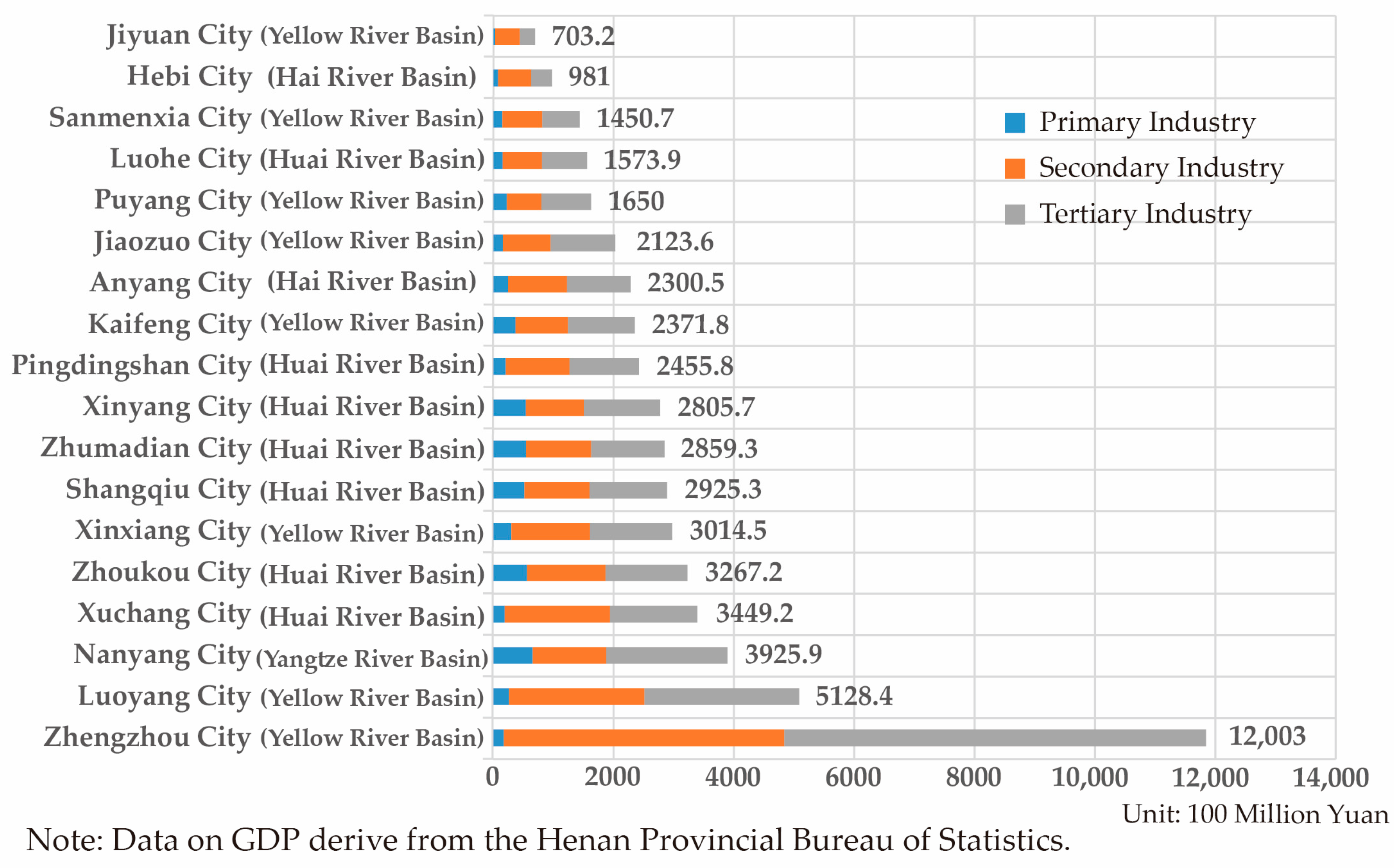
| Dimensional Layer | Element Layer | Indicator Layer | Impact Directions |
|---|---|---|---|
| Exposure | Human activity interference | Population density (X1) | Positive |
| Domestic water consumption per capita (X2) | Positive | ||
| Total wastewater discharge (X3) | Positive | ||
| Water resource development and utilization rate (X4) | Positive | ||
| Human-induced construction interference | Industrial wastewater discharge (X5) | Positive | |
| Agricultural irrigation water consumption per mu (X6) | Positive | ||
| Consumption of chemical fertilizer by 100% effective component per mu (X7) | Positive | ||
| Consumption of chemical pesticides per mu (X8) | Positive | ||
| Land-use change interference | Built-up area (X9) | Positive | |
| Cultivated land area (X10) | Positive | ||
| Sensitivity | Water volume | Water resources per capita (X11) | Negative |
| Groundwater resources per capita (X12) | Negative | ||
| Water production modulus (X13) | Negative | ||
| Water quality | Water quality excellence rate in watershed (X14) | Negative | |
| Water quality of urban centralized drinking water source (X15) | Negative | ||
| Water quality of urban groundwater (X16) | Negative | ||
| Sensitivity of climate to external interference | Water production coefficient (X17) | Negative | |
| Absolute value of coefficient of variation in annual precipitation (X18) | Positive | ||
| Proportion of rainfall during flood season (X19) | Positive | ||
| Adaptability | Economic development | Per capita GDP (X20) | Negative |
| Local general budgetary revenue (X21) | Negative | ||
| Per capita disposable income of urban residents (X22) | Negative | ||
| Technology | Water consumption per 10,000 yuan of GDP (X23) | Positive | |
| Water consumption rate (X24) | Positive | ||
| Pollution control | Urban wastewater treatment rate (X25) | Negative | |
| Treatment capacity of wastewater treatment plants (X26) | Negative | ||
| Length of drainage pipes (X27) | Negative | ||
| Density of drainage pipes (X28) | Negative | ||
| Willingness for water resource protection and construction | Proportion of expenditure on agriculture, forestry, and water conservancy to local general budgetary expenditure (X29) | Negative | |
| Number of water, environmental, and public facility management personnel per 10,000 people (X30) | Negative | ||
| Coverage rate of green areas in built-up areas (X31) | Negative | ||
| Water-saving irrigation machinery per 100 mu (X32) | Negative |
| Water Resource Subsystem | Year | Longitude of Center of Gravity (°E) | Latitude of Center of Gravity (°N) | Standard Deviation (km) along the X Axis | Standard Deviation (km) Along the Y Axis | Area of an Ellipse (10,000 km2) | Direction Angle | Shape Index |
|---|---|---|---|---|---|---|---|---|
| Exposure | 2000 | 113.80 | 34.49 | 161.46 | 191.66 | 9.72 | 34.13 | 0.84 |
| 2010 | 113.83 | 34.49 | 157.43 | 192.92 | 9.54 | 27.46 | 0.82 | |
| 2020 | 113.71 | 34.57 | 149.95 | 186.70 | 8.79 | 38.48 | 0.80 | |
| Sensitivity | 2000 | 113.86 | 34.45 | 166.11 | 193.02 | 10.07 | 44.91 | 0.86 |
| 2010 | 113.78 | 34.50 | 169.06 | 196.51 | 10.44 | 51.46 | 0.86 | |
| 2020 | 113.79 | 34.43 | 185.08 | 198.95 | 11.57 | 39.18 | 0.93 | |
| Adaptation Capacity | 2000 | 113.83 | 34.40 | 181.27 | 199.51 | 11.36 | 18.50 | 0.91 |
| 2010 | 113.79 | 34.38 | 181.57 | 200.64 | 11.44 | 28.86 | 0.90 | |
| 2020 | 113.75 | 34.36 | 187.20 | 194.96 | 11.47 | 32.65 | 0.96 | |
| Vulnerability | 2000 | 113.84 | 34.43 | 173.28 | 194.87 | 10.60 | 33.02 | 0.89 |
| 2010 | 113.80 | 34.45 | 171.86 | 196.49 | 10.61 | 34.66 | 0.87 | |
| 2020 | 113.76 | 34.45 | 177.91 | 194.95 | 10.90 | 36.99 | 0.91 |
| Water Resource Subsystem | Exposure | Sensitivity | Adaptability |
|---|---|---|---|
| 2000 | 0.4415 | 0.7396 | 0.5352 |
| 2010 | 0.8604 | 0.5128 | 0.4252 |
| 2020 | 0.7342 | 0.7406 | 0.3042 |
| Basin | Suggestions for Adaptive Management of WRV in the Yellow-Huai-Hai-Yangtze River Basins |
|---|---|
| Huai River Basin |
|
| Yellow River Basin |
|
| Hai River Basin |
|
| Yangtze River Basin |
|
Disclaimer/Publisher’s Note: The statements, opinions and data contained in all publications are solely those of the individual author(s) and contributor(s) and not of MDPI and/or the editor(s). MDPI and/or the editor(s) disclaim responsibility for any injury to people or property resulting from any ideas, methods, instructions or products referred to in the content. |
© 2023 by the authors. Licensee MDPI, Basel, Switzerland. This article is an open access article distributed under the terms and conditions of the Creative Commons Attribution (CC BY) license (https://creativecommons.org/licenses/by/4.0/).
Share and Cite
Tian, Z.; Zhang, R.; Wu, L.; Wang, Y.; Yang, J.; Cao, D. Spatiotemporal Evaluation of Water Resource Vulnerability in Four River Basins of Henan Province, China. Water 2024, 16, 149. https://doi.org/10.3390/w16010149
Tian Z, Zhang R, Wu L, Wang Y, Yang J, Cao D. Spatiotemporal Evaluation of Water Resource Vulnerability in Four River Basins of Henan Province, China. Water. 2024; 16(1):149. https://doi.org/10.3390/w16010149
Chicago/Turabian StyleTian, Zhihui, Ruoyi Zhang, Lili Wu, Yongji Wang, Jinjin Yang, and Di Cao. 2024. "Spatiotemporal Evaluation of Water Resource Vulnerability in Four River Basins of Henan Province, China" Water 16, no. 1: 149. https://doi.org/10.3390/w16010149
APA StyleTian, Z., Zhang, R., Wu, L., Wang, Y., Yang, J., & Cao, D. (2024). Spatiotemporal Evaluation of Water Resource Vulnerability in Four River Basins of Henan Province, China. Water, 16(1), 149. https://doi.org/10.3390/w16010149






